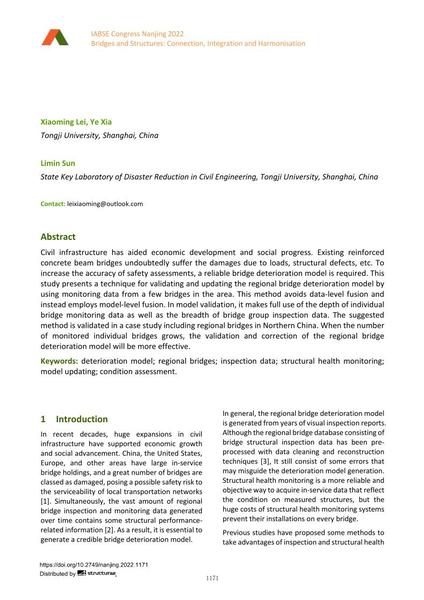Validation and Updating of Regional Bridge Deterioration Model Incorporating Structural Health Monitoring

|
|
|||||||||||
Détails bibliographiques
| Auteur(s): |
Xiaoming Lei
(Tongji University, Shanghai, China)
Ye Xia (Tongji University, Shanghai, China) Limin Sun |
||||
|---|---|---|---|---|---|
| Médium: | papier de conférence | ||||
| Langue(s): | anglais | ||||
| Conférence: | IABSE Congress: Bridges and Structures: Connection, Integration and Harmonisation, Nanjing, People's Republic of China, 21-23 September 2022 | ||||
| Publié dans: | IABSE Congress Nanjing 2022 | ||||
|
|||||
| Page(s): | 1171-1176 | ||||
| Nombre total de pages (du PDF): | 6 | ||||
| DOI: | 10.2749/nanjing.2022.1171 | ||||
| Abstrait: |
Civil infrastructure has aided economic development and social progress. Existing reinforced concrete beam bridges undoubtedly suffer the damages due to loads, structural defects, etc. To increase the accuracy of safety assessments, a reliable bridge deterioration model is required. This study presents a technique for validating and updating the regional bridge deterioration model by using monitoring data from a few bridges in the area. This method avoids data-level fusion and instead employs model-level fusion. In model validation, it makes full use of the depth of individual bridge monitoring data as well as the breadth of bridge group inspection data. The suggested method is validated in a case study including regional bridges in Northern China. When the number of monitored individual bridges grows, the validation and correction of the regional bridge deterioration model will be more effective. |
||||
| Copyright: | © 2022 International Association for Bridge and Structural Engineering (IABSE) | ||||
| License: | Cette oeuvre ne peut être utilisée sans la permission de l'auteur ou détenteur des droits. |
||||
